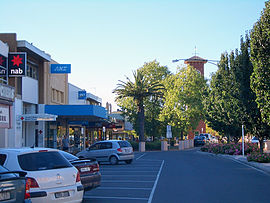Sale, Victoria
|
Sale Victoria |
|||||||||||||
|---|---|---|---|---|---|---|---|---|---|---|---|---|---|

View of the Sale city centre toward the mall
|
|||||||||||||
| Coordinates | 38°06′S 147°04′E / 38.100°S 147.067°ECoordinates: 38°06′S 147°04′E / 38.100°S 147.067°E | ||||||||||||
| Population | 14,716 (2015) | ||||||||||||
| • Density | 322.7/km2 (835.8/sq mi) | ||||||||||||
| Established | 1851 | ||||||||||||
| Area | 45.6 km2 (17.6 sq mi) (2011 urban) | ||||||||||||
| Location |
|
||||||||||||
| LGA(s) | Shire of Wellington | ||||||||||||
| State electorate(s) | Gippsland South | ||||||||||||
| Federal Division(s) | Gippsland | ||||||||||||
|
|||||||||||||
Sale is a city situated in the Gippsland region of the Australian state of Victoria. It had an estimated urban population of 14,716 at June 2015. Sale has seen much development and redevelopment in the past decade, one example being the multimillion-dollar redevelopment of the city's Port of Sale.
The Aboriginal name for the Sale area was Wayput. Two famous Gippsland explorers, Paul Strzelecki and Angus McMillan, passed through the immediate area around 1840. The first white settler was Archibald McIntosh who arrived in 1844 and established his 'Flooding Creek' property on the flood plain country which was duly inundated soon after his arrival.
In the 1840s, drovers heading south to Port Albert crossed Flooding Creek and were confronted with the difficult marsh country around the Thomson and Latrobe rivers. A punt operated across the Latrobe River until a toll bridge was erected. A Post Office named Flooding Creek opened here on 30 September 1848 being renamed, somewhat belatedly, as Sale on 1 January 1854.
The first town plots went on sale in 1850. When the new settlement was gazetted in 1851 it was named 'Sale' — a tribute to General Sir Robert Sale, a British army officer who won fame in the first Afghan war before being killed in battle in India in 1845. An SBS TV documentary "Afghanistan: The Great Game" claims that it is actually named after his wife, Lady Florentia Sale (1790-1853), who wrote a famous journal of her experiences during the First Afghan War which became a best seller in the 1840s and was serialised in The Times (UK) and possibly in Australia. Certainly, her letters to her husband were enthusiastically published in Australian papers.
The town greatly benefitted from the 1851 gold rush at Omeo as it was situated on the Port Albert to Omeo route and was an important base for the goldfields, until the arrival of the railways. It was also an important service centre for East Gippsland and the Monaro Plains of New South Wales. A building boom took place c. 1855–65.
...
Wikipedia

